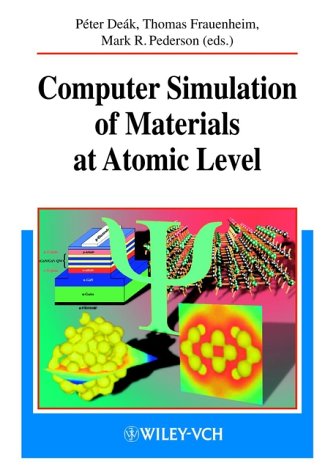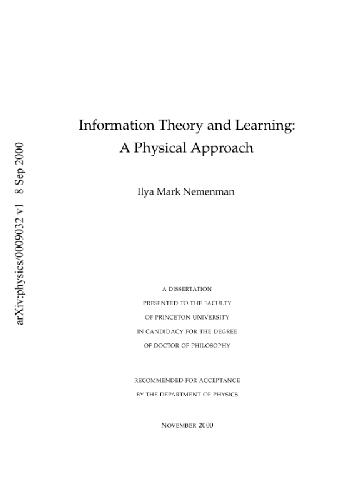Howard Georgi0738202339, 9780738202334
Howard Georgi is the co-inventor (with Sheldon Glashow) of the SU(5) theory. This extensively revised and updated edition of his classic text makes the theory of Lie groups accessible to graduate students, while offering a perspective on the way in which knowledge of such groups can provide an insight into the development of unified theories of strong, weak, and electromagnetic interactions.
Table of contents :
Cover ……Page 1
Title page ……Page 2
Date-line ……Page 3
Dedication ……Page 4
Preface to the Revised Edition ……Page 5
Contents ……Page 6
Why Group Theory? ……Page 12
1.1 Groups and representations ……Page 13
1.2 Example – $Z_3$ ……Page 14
1.3 The regular representation ……Page 15
1.4 Irreducible representations ……Page 16
1.5 Transformation groups ……Page 17
1.6 Application: parity in quantum mechanics ……Page 18
1.7 Example: $S_3$ ……Page 19
1.8 Example: addition of integers ……Page 20
1.9 Useful theorems ……Page 21
1.10 Subgroups ……Page 22
1.11 Schur’s lemma ……Page 24
1.12 * Orthogonality relations ……Page 28
1.13 Characters ……Page 31
1.14 Eigenstates ……Page 36
1.15 Tensor products ……Page 37
1.16 Example of tensor products ……Page 38
1.17 * Finding the normal modes ……Page 40
1.18 * Symmetries of $2n+1$-gons ……Page 44
1.19 Pennutation group on $n$ objects ……Page 45
1.20 Conjugacy classes ……Page 46
1.21 Young tableaux ……Page 48
1.24 * Young tableaux and representations of $S_n$ ……Page 49
2.1 Generators ……Page 54
2.2 Lie algebras ……Page 56
2.3 The Jacobi identity ……Page 58
2.4 The adjoint representation ……Page 59
2.5 Simple algebras and groups ……Page 62
2.6 States and operators ……Page 63
2.7 Fun with exponentials ……Page 64
3.1 $J_3$ eigenstates ……Page 67
3.2 Raising and lowering operators ……Page 68
3.3 The standard notation ……Page 71
3.4 Tensor products ……Page 74
3.5 $J_3$ values add ……Page 75
4.1 Orbital angular momentum ……Page 79
4.2 Using tensor operators ……Page 80
4.3 The Wigner-Eckart theorem ……Page 81
4.4 Example ……Page 83
4.5 * Making tensor operators ……Page 86
4.6 Products of operators ……Page 88
5.1 Charge independence ……Page 90
5.2 Creation operators ……Page 91
5.4 Isospin generators ……Page 93
5.5 Symmetry of tensor products ……Page 94
5.6 The deuteron ……Page 95
5.7 Superselection rules ……Page 96
5.8 Other particles ……Page 97
5.10 Perturbation theory ……Page 99
6.1 Weights ……Page 101
6.2 More on the adjoint representation ……Page 102
6.3 Roots ……Page 103
6.5 Lots of $SU(2)$s ……Page 104
6.6 Watch carefully – this is important! ……Page 106
7.1 The Gell-Mann matrices ……Page 109
7.2 Weights and roots of $SU(3)$ ……Page 111
8.1 Positive weights ……Page 114
8.2 Simple roots ……Page 116
8.3 Constructing the algebra ……Page 119
8.4 Dynkin diagrams ……Page 122
8.6 The roots of $G_2$ ……Page 123
8.7 The Cartan matrix ……Page 125
8.8 Finding all the roots ……Page 126
8.9 The $SU(2)$s ……Page 128
8.10 Constructing the $G_2$ algebra ……Page 129
8.11 Another example: the algebra $G_3$ ……Page 131
8.12 Fundamental weights ……Page 132
8.13 The trace of a generator ……Page 134
9.1 Fundamental representations of $SU(3)$ ……Page 136
9.2 Constructing the states ……Page 138
9.3 The Weyl group ……Page 141
9.4 Complex conjugation ……Page 142
9.5 Examples of other representations ……Page 143
10.1 lower and upper indices ……Page 149
10.2 Tensor components and wave functions ……Page 150
10.3 Irreducible representations and symmetry ……Page 151
10.5 Clebsch-Gordan decomposition ……Page 152
10.7 Matrix elements and operators ……Page 154
10.8 Normalization ……Page 155
1O.10 The dimension of $(n, m)$ ……Page 156
10.11 * The weights of $(n, m)$ ……Page 157
10.12 Generalization of Wigner-Eckart ……Page 163
10.13 * Tensors for $SU(2)$ ……Page 165
10.14 * Clebsch-Gordan coefficients from tensors ……Page 167
10.15 * Spin $s_1 + s_2 – 1$ ……Page 168
10.16 * Spin $s_1 + s_2 – k$ ……Page 171
11.1 The eight-fold way ……Page 177
11.2 The Gell-Mann Okubo formula ……Page 180
11.3 Hadron resonances ……Page 184
11.4 Quarks ……Page 185
12.1 Raising the indices ……Page 189
12.2 Clebsch-Gordan decomposition ……Page 191
12.3 $SU(3) to SU(2) times U(1)$ ……Page 194
13.1 Generalized Gell-Mann matrices ……Page 198
13.2 $SU(N)$ tensors ……Page 201
13.3 Dimensions ……Page 204
13.4 Complex representations ……Page 205
13.5 $SU(N) otimes SU(M) in SU(N+M)$ ……Page 206
14.1 Raising and lowering operators ……Page 209
14.3 A more complicated example ……Page 211
15.1 Including the spin ……Page 216
15.2 $SU(N) otimes SU(M) in SU(NM)$ ……Page 217
15.3 The baryon states ……Page 219
15.4 Magnetic moments ……Page 221
16.1 Colored quarks ……Page 225
16.2 Quantum Chromodynamics ……Page 229
16.4 Flavor $SU(4)$ is useless! ……Page 230
17.1 The nonrelativistic limit ……Page 232
18.1 Grand unification ……Page 236
18.2 Parity violation, helicity and handedness ……Page 237
18.3 Spontaneously broken symmetry ……Page 239
18.4 Physics of spontaneous symmetry breaking ……Page 240
18.5 Is the Higgs real? ……Page 241
18.6 Unification and $SU(5)$ ……Page 242
18.7 Breaking $SU(5)$ ……Page 245
18.8 Proton decay ……Page 246
19.1 The $SO(2n)$ algebras ……Page 248
19.2 The $SO(2n+1)$ algebras ……Page 249
19.3 The $Sp(2n)$ algebras ……Page 250
19.4 Quaternions ……Page 251
20.1 $Pi$-systems ……Page 255
20.2 Regular subalgebras ……Page 262
20.3 Other Subalgebras ……Page 264
21.1 Fundamental weight of $SO(2n+1)$ ……Page 266
21.2 Real and pseudo-real ……Page 270
21.3 Real representations ……Page 272
21.6 The explicit form for $R$ ……Page 273
22.1 Fundamental weights of $SO(2n+2)$ ……Page 276
23.1 Clifford algebras ……Page 281
23.2 $Gamma_m$ and $R$ as invariant tensors ……Page 283
23.3 Products of $Gamma$s ……Page 285
23.4 Self-duality ……Page 288
23.6 The $SU(n)$ subalgebra ……Page 290
24.1 $SO(10)$ and $SU(4) times SU(2) times SU(2)$ ……Page 293
24.3 * Breaking $SO(10) to SU(5)$ ……Page 296
24.4 * Breaking $SO(10) to SU(3) times SU(2) times U(1)$ ……Page 298
24.6 * Lepton number as a fourth color ……Page 300
25.1 Outer automorphisms ……Page 302
25.2 Fun with $SO(8)$ ……Page 304
26.1 Weights of $SU(n)$ ……Page 308
26.2 Tensors for $Sp(2n)$ ……Page 310
27.1 Exceptional algebras and octonians ……Page 313
27.2 $E_6$ unification ……Page 315
27.4 $SU(3) times SU(3) times SU(3)$ unification ……Page 319
27.5 Anomalies ……Page 320
Epilogue ……Page 322
Index ……Page 323







Reviews
There are no reviews yet.